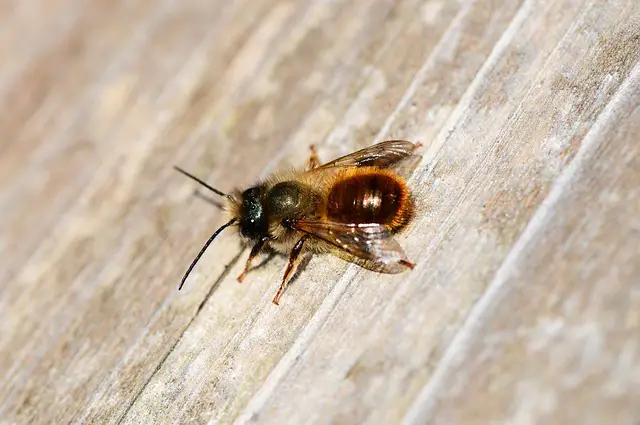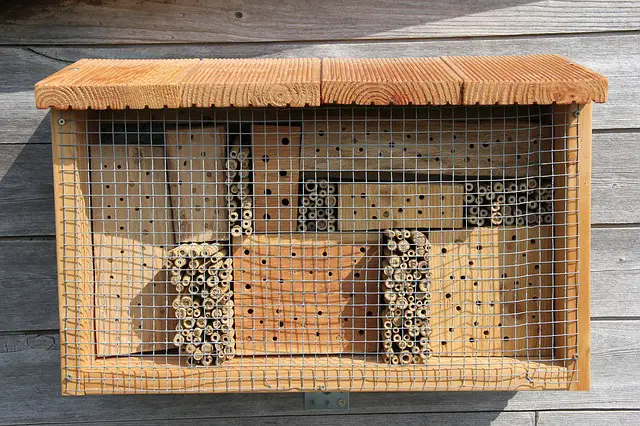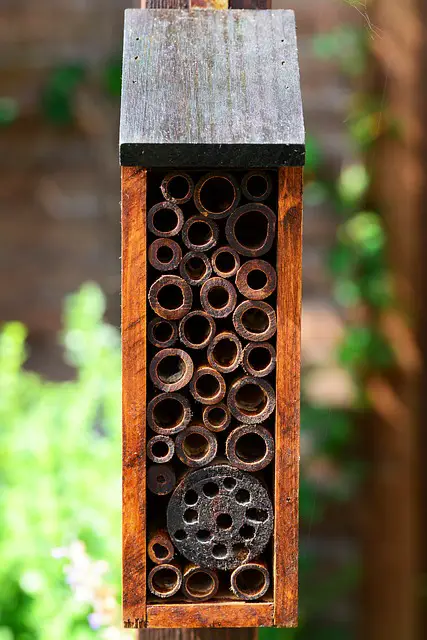Mason bees are a hard-working variety of bee that don’t require very much work or effort. Mason bees are excellent pollinators that require minimal management and effort. Mason bees have been used by farmers for centuries with great benefits.
Mason bees don’t sting, are easily cultivated, are naturally occurring, and don’t require much maintenance. They can be a powerhouse for pollination in your garden. They are easily introduced to your garden, homestead, or farm. You can even cultivate them fairly easily to have them working for you for years.
What is a Mason Bee?

A mason bee is a small solitary bee. Unlike honey bees where only one queen is fertile, all female mason bees are fertile and lay eggs. Mason bees don’t have a social structure like honey bees. Some may form a loose social structure with mother and daughter bees for a while, but they are mostly solitary.
Different species of mason bees are found worldwide. Mason bees are smaller than bumble bees or honey bees. They are generally a different color then a honey bee. Mason bees can be a metallic green or blue, rusty red, and black. One great thing about mason bees is that they do not sting! A great benefit, especially for those who are allergic to bee stings.
Mason bees are great pollinators and occur naturally throughout the world. They are easily cultivated and are not susceptible to varroa mites, the parasites that are decimating honey bees.
Life Cycle of the Mason Bee
Mason bees will hatch out in the spring. Generally March or April depending on your climate. The males will hatch out first, waiting for the females to hatch. The mason bees will mate and the male bees will die within a few days. The females will then get ready to lay their eggs.
When the females are ready to lay eggs, they find a suitable place to make their nest. They will use anything that is small and hollow. Nests have been found in holes from carpenter bees, empty snail shells, hollow sticks, cracks in rocks, etc.
The mason bees then create cells. These cells are made from dabs of mud and/or chewed up leaves. This is where they get the name of mason from the mud masonry in their cells and nests.
They begin the cell and go on a pollen and nectar run. They will pack the cell end with nectar and pollen and lay an egg on top of the food supply. Then the mason bee will seal the cell off and begin another cell. This process will continue until they fill the nest site.
The female eggs will be in the bottom or inner part of the nest and the males will be laid towards the entrance. Once all the space has been filled, they seal off the nest and go find another nest site and do it again.
Are Mason Bees Better than Honey Bees?
If you want an easy almost carefree pollinator, mason bees are difficult to beat. They don’t swarm or sting, and are mostly just a small docile little helper. However, they do not offer any products that a honey bee does.
Honey bees offer pollination, honey, wax, propolis, and a possible income. Honey bees require investment of time, energy, and equipment. Honey bees will swarm and do need maintenance. Honey bee stings can be painful, and cause big problems if you are allergic to their stings.
It’s a difficult question to answer, whether mason bees are better than honey bees? Both types of bees have their good points. I would say try honey bees if you are interested, have the time, and are not allergic to them. If you just want to have some good pollinators without all the work of honey bees then try the mason bees.
I have worked with both kinds of bees. I like all the products you get from honey bees. I do like the idea of low maintenance with the mason bees however. I guess I lean more towards honey bees, just for all the cool stuff you get from them.
How Do You Use Mason Bees?
Mason bees are really simple to use in your garden. You get the nests and hang them in a suitable part of your garden. You will want to have them close to the garden, but probably not right in the middle of garden and yard operations.
Once you have the collection of mason bee nests located you just let them do their thing. The male bees will hatch out first and wait at the entrance for the female bees to hatch out. Once the females emerge, they mate with the males, and the male bees will soon die. The female bees will then go through the process of creating their own new nests. This is where the pollination occurs.
Where Do You Get Mason Bees?
Mason bees have been a popular pollinator for years. You can get them from various sources. I will include links on my resource page for mason bees.
You can also put out mason bee houses. These houses encourage the mason bees that may be around to build their nests where you want them to. These houses can be fairly simple or can be constructed to be a decorative addition to your garden.
Growing up many of the local farmers knew the benefit of these small power pollinators. We made several simple mason bee houses and hung them on the outside of the sheds and barns around the place. The houses we constructed were houses in the technical sense but didn’t really resemble a house at all. They were boards with holes drilled in them creating the hollow tubes for the bees to make their cells.
Make Your Own Mason Bee House.

Making your own mason bee house is pretty easy. You can do it as simply as drilling 5/16-inch holes into a board. The deeper the hole the better. The holes need to be about 6 inches deep or more. Don’t do more than 25 holes per board. The bees can sometimes get confused with too many holes to try to figure out. You can then hang the things all over the place. You might get a lot of bees attracted to them and they will use them as nesting sites.

You can get a bit more decorative with them by finding nifty pieces of bamboo or hollow sticks and arranging them in a framework. I have seen simple frames made to look like a house, or an organic shape with the hollow bamboo or sticks inside. The key is to have the hollow tubes horizontal to the ground, and easy access for the bees. The hollows of the bamboo or sticks need to be around 5/16-inch. They can vary a little, but that is the approximate size.
A more practical mason bee home is with straws. Paper straws are effective as cell building homes. You can bunch them up in a can or line the holes you drilled in the boards. This will let you inspect the mason bee nests a little more closely. With this method they may not be as decorative, but you can inspect and eliminate any pests. You might be able to create a better population of mason bees in the spring. If you do pull the straws when they are capped off, you can store them in a covered bucket or tote. Just make sure you drill a 5/16-inch hole in the top. The bees will fly out of there when they hatch in the spring.
I remember farmers would come and buy the mason bee boards that we made when I was a kid. It was a fun way to make some extra money. I know that the bees were really effective in increasing the yield of the farmers crop by quite a bit.
Mason Bees are a Great Pollinator.
Mason bees are great little docile workers. They will increase your yield with good pollination. You will probably not want to introduce them if you are already keeping honey bees. They will compete for the same resources. That might be fine on a farm or ranch, but in a backyard garden that might be a bit too much competition for the space you have.
If you don’t have honey bees then mason bees are a great option. They don’t require very much to introduce them, and they are really effective.

